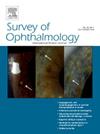Challenging corneal diseases and microRNA expression: Focus on rare diseases and new therapeutic frontiers
IF 5.1
2区 医学
Q1 OPHTHALMOLOGY
引用次数: 0
Abstract
MicroRNAs (miRNAs) function as posttranscriptional regulators of gene expression by targeting specific messenger RNA (mRNA). This interaction modulates mRNA stability or translational efficiency, ultimately impacting the level of protein production. Emerging evidence suggests that miRNAs act as critical regulators in corneal diseases. These molecules finetune key processes like cell proliferation, differentiation, inflammation, and wound healing. We reviewed the literature to understand the role that miRNAs may play in the development of challenging and poorly understood corneal diseases. We focused on vernal keratoconjunctivitis, neurotrophic keratitis, keratoconus, Fuchs endothelial corneal dystrophy, and limbal stem cell deficiency. Furthermore, we explored currently studied agonists or antagonists of miRNAs that share similar pathways with ocular diseases and could be employed in ophthalmology in the future. The distinct miRNA expression profiles observed in different ocular surface pathologies, combined with the remarkable stability and relatively easy access of miRNA sampling in biofluids, present possibilities for the development of noninvasive and highly accurate diagnostic tools. Furthermore, comprehending miRNA's pathophysiological role could open new frontiers to a more comprehensive understanding of the pathophysiology underlying ocular surface diseases, thereby paving the way for the creation of novel therapeutic strategies.
挑战性角膜疾病与 miRNA 表达:聚焦罕见疾病和新的治疗前沿。
微小核糖核酸(miRNA)通过靶向特定的信使核糖核酸(mRNA),发挥基因表达转录后调节器的作用。这种相互作用可调节 mRNA 的稳定性或翻译效率,最终影响蛋白质的生成水平。新的证据表明,miRNA 是角膜疾病的关键调节因子。这些分子对细胞增殖、分化、炎症和伤口愈合等关键过程进行微调。我们查阅了相关文献,以了解 miRNA 在具有挑战性且鲜为人知的角膜疾病的发展过程中可能扮演的角色。我们重点研究了包括虹膜性角膜结膜炎、神经营养性角膜炎、角膜炎、福氏内皮性角膜营养不良和角膜缘干细胞缺乏症在内的角膜疾病。此外,我们还探讨了目前研究的 miRNA 激动剂或拮抗剂,它们与眼部疾病有相似的通路,将来可用于眼科。在不同眼表病变中观察到的不同 miRNA 表达谱,加上生物流体中取样的 miRNA 具有显著的稳定性且相对容易获取,这些都为开发非侵入性和高度准确的诊断工具提供了可能性。此外,了解 miRNA 的病理生理学作用可为更全面地了解眼表疾病的病理生理学开辟新的领域,从而为制定新型治疗策略铺平道路。
本文章由计算机程序翻译,如有差异,请以英文原文为准。
求助全文
约1分钟内获得全文
求助全文
来源期刊

Survey of ophthalmology
医学-眼科学
CiteScore
10.30
自引率
2.00%
发文量
138
审稿时长
14.8 weeks
期刊介绍:
Survey of Ophthalmology is a clinically oriented review journal designed to keep ophthalmologists up to date. Comprehensive major review articles, written by experts and stringently refereed, integrate the literature on subjects selected for their clinical importance. Survey also includes feature articles, section reviews, book reviews, and abstracts.
 求助内容:
求助内容: 应助结果提醒方式:
应助结果提醒方式:


